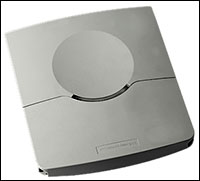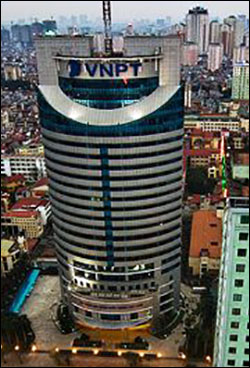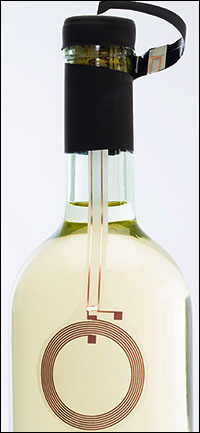May 14, 2015The following are news announcements made during the past week by the following organizations:
Nedap, Vietnam Post and Telecom Group;
Thinfilm, World Customs Organization;
Farfetch;
Atlas RFID Solutions; and
SML Group.
Vietnam Post and Telecom Selects Nedap Tags, Readers for Building, Elevator Access
Nedap, a manufacturer of security and inventory-management solutions, has announced that the Vietnam Post and Telecommunication (VNPT) has recently upgraded its headquarters with Nedap's uPASS Reach readers and Combi cards to facilitate hands-free building and elevator access.
Located in central Hanoi, Vietnam, VNPT has 1,000 employees working at the headquarters, according to Nedap, and access-control systems for managing vehicles and individuals are needed to guarantee a convenient and secure flow of people. The entire project included access-control readers for automatic vehicle identification at the building's parking facilities, elevator management and hands-free door access.
The uPASS Reach, which complies with the ISO 18000-6C and EPC Gen 2 ultrahigh-frequency (UHF) RFID standards, features an integrated, fine-tuned antenna in a compact enclosure, measuring 200 millimeters by 220 millimeters by 45 millimeters (7.9 inches by 8.7 inches by 1.8 inches), and is IP65-rated, so it can be used both indoors and outdoors. Built-in high-intensity red, green and blue LEDs provide a user with visual feedback that the tag has been read or authorized. The LED and beeper functionality can be controlled via the access-control panel, but can also be preconfigured. The device also features a tamper switch to immediately provide tamper-evident indication.
The Combi cards that VNPT is using combine a passive UHF inlay and NXP Semiconductors' high-frequency (HF) Mifare technology, Nedap thus. Thus, the company's employees and visitors need only a single card to gain authorized access to the parking lot, as well as to the 184 doors and elevators throughout the entire premises. This makes the solution cost-efficient.
Nedap partner Techpro installed Nedap's uPASS Reach readers in combination with an elevator access-control system from IDTECK to help control the six passenger elevators in the building's 27 floors. Only those with an authorized access credential can operate elevators with call buttons. All exit doors at the stairs are also equipped with Nedap's uPASS readers for tracking purposes. With this solution, Nedap explains, VNPT ensures convenient and secure hands-free elevator access to all of its authorized employees and registered visitors.
Prior to the technology's installation, VNPT's security department found it burdensome to monitor the comings and goings of hundreds of daily visitors, according to Techpro's director, Do Duc Hau. The new installation, he says, makes it easier to grant access to authorized visitors to the correct floor and the right department. Visitor information can now also be stored, and can provide support for management purposes.
World Customs Organization Adds Thinfilm Tags to Anti-counterfeiting Platform
Printed electronics company Thin Film Electronics (Thinfilm) has announced that its Near Field Communication (NFC) products will be the first NFC-based solutions to be integrated with the Interface Public-Members (IPM) anti-counterfeiting tool that the World Customs Organization (WCO) offers to its members. The WCO focuses on customs procedures and regulations governing trade between countries, and its members consist of the customs agencies of 179 nations.
The tool, an online and mobile database application enabling rights holders to provide customs officers with real-time data about their products, was first introduced in 2010, and is used by the 85 countries that have joined the IPM program. According to the WCO, the Web-based tool, accessible with a login and password via a dedicated and secure interface, is designed to allow operational data concerning products to be communicated directly to customs officers on the ground, facilitating the identification of counterfeit goods. The tool can also be integrated into existing intranet systems and is available on mobile devices.
Thinfilm's NFC OpenSense and NFC Barcode passive 13.45 MHz RFID tags can enhance brand security and provide a wider range of product protection, according to the company. The tags are designed to be easy to use and work with NFC-enabled smartphones, tablets or industrial readers, with no special hardware or infrastructure required. The NFC OpenSense tag, which was made commercially available earlier this year (see Thinfilm Launches OpenSense Printed NFC Sensor Label for Bottles) offers 128 bits of read-only memory. A unique identifier within each OpenSense tag supports enhanced product authentication, Thinfilm explains, by identifying if a seal has been broken anywhere along the supply chain.
The NFC OpenSense and NFC Barcode tags will be part of the WCO's "IPM Connected" offering, a global network of track-and-trace and authentication solutions interfaced with IPM. All IPM Connected products are available as WCO-approved solutions, and can be purchased by all WCO IPM members. Members who employ IPM will have the ability to use Thinfilm's NFC tags on their products, and a purpose-built application provided by Thinfilm will provide customs officers with real-time authentication capabilities via an NFC smartphone or other reading device. According to Thinfilm, customs officers can simply scan a tag, and IPM will automatically launch the application, allowing them to instantly verify a product's authenticity via a global database.
Farfetch to Turn Fashion Retailer Browns Into an RFID-enabled Store of the Future
U.K. online fashion retailer Farfetch has announced that it has acquired upscale retailer Browns, based in London, for an undisclosed sum in cash and shares, Reuters has reported. According to media reports, Farfetch will operate Browns, which opened in 1970 and was an early adopter of e-commerce, as an incubator for retail technology.
Browns will become part of a project Farfetch has launched called the "Store of the Future," to test new digital, RFID and Near Field Communication (NFC) technologies designed to help manage inventory and evaluate shoppers' desires, according to the Wall Street Journal. RFID and NFC chips will be attached to the garments in the store, the Wall Street Journal reports, and mobile payment will allow consumers to shop from their home or hotel room.
Farfetch was founded in 2008, with offices in London, New York, Los Angeles, São Paulo, Brazil, and Porto, Portugal. The company operates more than 300 independent fashion boutiques, as well as an e-commerce website. The retailer carries more than 1,000 fashion labels, and online shoppers can buy from any of the fashion boutiques around the world through Farfetch's website. Browns, according to its website, has grown into a fashion landmark since it first opened as a small boutique in 1970, and its cofounder, Joan Burstein, is credited with discovering such talents as John Galliano, Alexander McQueen, Hussein Chalayan and Commes des Garcons.
Atlas RFID Solutions Announces Upgrade to Jovix Materials-Management Solution
Atlas RFID Solutions has announced a new version of its flagship product, Jovix, an RFID solution consisting of tags and readers to monitor materials and tools at oil and gas facilities, power plants, and similar industrial construction projects—often from the point of an item's manufacture until it is built into the facility.
The 2015.1 release of Jovix includes enhanced business-intelligence dashboards and reporting capabilities, which can be configured to provide value for a wide range of stakeholders throughout the material lifecycle. The key value of this new release, the company indicates, is an expansion of the ability to quickly turn vast amounts of data into actionable information, which is displayed in a single convenient location. The new release also includes new features aimed at improving a company's ability to identify issues and resolve them before they impact construction. For example, a newly added dashboard with configurable, personalized widgets can automate the process of highlighting issues on an exception basis in a graphical, easy-to-consume format. A series of reports linked to the dashboard charts and graphs enable users to quickly drill down into issues and initiate the resolution process—which, Atlas RFID says, saves valuable time and money by increasing productivity and efficiency on the job site.
SML Group Joins RAIN RFID Alliance
SML Group, a global RFID label manufacturer based in Hong Kong, has announced that it has joined the RAIN RFID Alliance, an organization whose mission is to promote the adoption of EPC ultrahigh-frequency (UHF) RFID technology (see Technology Companies Create RAIN to Promote EPC UHF RFID Adoption). To date, 70 companies have become members of the RAIN RFID Alliance since its founding in April 2014.
SML Group is one of the largest providers of RFID labels to the retail market for item-level RFID tracking, with more than 5,000 employees and operations in more than 30 countries. Its woven and printed labels, both RFID and non-RFID, are used on garments, footwear and other retail products worldwide, while the majority of its customers apply those labels in Asia, where the company is based. SML Group offers a portfolio of item-visibility solutions that cover a full range of paper, plastic and fabric RFID labels, as well as tickets and stickers that can be attached to hanging and stacked apparel items.
The solutions are designed to provide retailers with real-time item visibility via item-level EPC Gen 2 ultrahigh-frequency (UHF) tracking. SML's global footprint, combined with its deep experience in RFID-based item-level solutions, should provide a valuable and unique synergy with the RAIN Alliance, according to SML Group, thereby contributing to the mass adoption of RFID technology in retail supply chains.
According to Jim Donaldson, SML Group's spokesperson, the timing was right for the company to join the organization. "The RAIN RFID Alliance has grown its membership significantly in the last year," he says, "and that membership is a global community, representing every element of the RFID ecosystem." The company is looking forward to the member collaboration in the development of solutions to better serve key markets. "In addition," he says, "the RAIN RFID Alliance can play an important role in helping to educate SML partners and customers by providing awareness and initiatives to accelerate the understanding and adoption of the technology in business and consumer applications worldwide."




